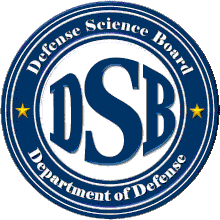
The Defense Science Board (DSB) is a committee of civilian experts appointed to advise the U.S. Department of Defense on scientific and technical matters. It was established in 1956 on the second Hoover Commission's recommendation.

The Defense Science Board (DSB) is a committee of civilian experts appointed to advise the U.S. Department of Defense on scientific and technical matters. It was established in 1956 on the second Hoover Commission's recommendation.
The Board's charter states its mission as:
The Board shall provide the Secretary of Defense, the Deputy Secretary of Defense, the Under Secretary of Defense for Acquisition, Technology and Logistics, the Chairman of the Joint Chiefs of Staff and, as requested, other Office of the Secretary of Defense (OSD) Principal Staff Assistants, the Secretaries of the Military Departments, the Commanders of the Combatant Commands, independent advice and recommendations on scientific, technical, manufacturing, acquisition process, and other matters of special interest to the Department of Defense. The Board is not established to advise on individual DoD procurements, but instead shall be concerned with the pressing and complex technology problems facing the Department of Defense in such areas as research, engineering, and manufacturing, and will ensure the identification of new technologies and new applications of technology in those areas to strengthen national security. No matter shall be assigned to the Board for its consideration that would require any Board Member to participate personally and substantially in the conduct of any specific procurement or place him or her in the position of acting as a "procurement officials," as that term is defined pursuant to law. The Under Secretary of Defense for Acquisition, Technology and Logistics or designated representative shall be authorized to act upon the advice and recommendations of the Board. [1]
The DSB conducts multiple simultaneous studies each year. Study topics are selected from requests made by the Department of Defense or Congressional leaders. In addition to studies that can start and stop at any time during the calendar year, the DSB usually conducts one or more "summer studies" each year; the term "summer study" refers to the fact that the panels meet as a large group in August each year (usually in Irvine, California) to work on these particular studies. Given that these meeting dates are well-established, it is normal for senior DoD personnel interested in the particular study topics for that year to come to the last day of the meeting and be briefed in person on the study findings to date. All DSB studies result in a written report, many of which are released to the public. [2]
Current study topics are also mostly listed on the DSB web page. [3]
The board shall be composed of not more than 45 members and not more than 12 senior fellow members who are eminent authorities in the fields of science, technology, manufacturing, acquisition, and other matters of particular interest to the Department of Defense. The Secretary of Defense shall appoint the board members, renewing their appointments annually. Those members, who are not full-time federal officers or employees, shall be appointed as experts and consultants under the authority of 5 U.S.C. Sec. 3109, and serve as special government employees. Members may be appointed for terms ranging from one to four years. Such appointments will normally be staggered among the board membership to ensure an orderly turnover in the board's overall composition periodically. Except for travel and per diem for official travel, they shall normally serve without compensation, unless otherwise authorized by the appointing authority. The Secretary of Defense, based upon the recommendation of the Under Secretary of Defense (Acquisition, Technology and Logistics), shall appoint the board's chairperson. The Under Secretary of Defense (Acquisition, Technology and Logistics) shall appoint the vice chairperson. The board chair and vice chair shall serve two-year terms and, with the Secretary of Defense's approval, may serve additional terms. The Secretary of Defense may invite other distinguished U.S. Government officers to serve as non-voting observers, and the Under Secretary of Defense for Acquisition, Technology, and Logistics may invite chairpersons from other DoD-supported federal advisory committees to serve as non-voting observers. The Under Secretary of Defense for Acquisition, Technology, and Logistics may appoint experts and consultants with unique expertise to assist the board on an ad hoc basis. These experts and consultants, appointed under the authority of 5 U.S.C. Sec. 3109, shall also serve as special government employees; however, they shall have no voting rights on the board. Non-voting observers and those non-voting experts and consultants appointed by the Under Secretary of Defense for Acquisition, Technology, and Logistics shall not count toward the Board's total membership.
The Defense Science Board was established in 1956 in response to recommendations of the Hoover Commission:
The Assistant Secretary of Defense (Research and Development) will appoint a standing committee, reporting directly to him, of outstanding basic and applied scientists. This committee will canvass periodically the needs and opportunities presented by new scientific knowledge for radically new weapons systems.
The original membership of the Board, totaling twenty-five, consisted of the chairman of the eleven technical advisory panels in the Office of the Assistant Secretary of Defense (Research and Development), the chairs of the senior advisory committees of the Army, Navy, and Air Force, the Directors of the National Science Foundation, the National Bureau of Standards, and the National Advisory Committee for Aeronautics (predecessor of the National Aeronautics and Space Administration), the President of the National Academy of Sciences, and seven members-at-large drawn from the scientific and technical community.
The Board met for the first time on September 20, 1956. Its initial assignment concerned the program and administration of basic research, component research, and the advancement of technology in areas of interest to the Department of Defense.
On December 31, 1956, a charter was issued specifying the Board as an advisory to the Assistant Secretary of Defense (Research and Development). Following the consolidation of the Assistant Secretaries of Defense for R&D and Applications Engineering offices in 1957, the Board reconstituted as advisory to the Secretary of Defense through the Assistant Secretary of Defense (Research and Engineering). Its membership was increased to 28, including ex officio members: the President's Science Advisory Committee Chairs and the Scientific Advisory Committee in the Office of Guided Missiles, Office of the Secretary of Defense (OSD). A revised Board charter was issued on October 30, 1957.
Following the Department of Defense Reorganization Act of 1958, which stipulated the responsibilities, functions, and authority of the Director of Defense Research and Engineering (DDR&E), the Board's charter was revised on November 23, 1959. This revision harmonized the role and mission of the Defense Science Board with DDR&D's responsibilities, prescribing eight members-at-large and modifying ex officio membership to conform with the establishment or dissolution of advisory panels in the office of the DDR&E.
While organizing his staff, the DDR&E appointed Assistant Directors for several warfare systems. Following this action in late 1959, the Board studied the structure of scientific and engineering advisory bodies. Its report on this study was implemented by DoD Directive 5129.22, "Defense Science Board Charter," dated April 10, 1961. This directive was revised and reissued on February 17, 1971. In 1978, the title Director of Defense Research and Engineering was changed to Under Secretary of Defense for Research and Engineering (USDRE). On July 1, 1986, the Undersecretary of Defense for Research and Engineering title was changed to Under Secretary of Defense for Acquisition (USD/A). On January 1, 1990, the Defense Manufacturing Board, which had reported directly to the USD(A), merged into the Defense Science Board, adding manufacturing issues to the list of items of interest.
Currently, the board's authorized strength is thirty-two members and seven ex officio members (the chairs of the Army, Navy, Air Force, Policy, Defense Business Board, and Defense Intelligence Agency advisory committees). The members are appointed for terms ranging from one to four years. They are selected based on their preeminence in science and technology and their application to military operations, research, engineering, manufacturing, and acquisition processes.
The board operates by forming task forces consisting of board members and other consultants/experts to address those tasks referred to by formal direction. The products of each task force typically consist of a set of formal briefings to the board and appropriate DoD officials and a written report containing findings, recommendations, and a suggested implementation plan. The board reports directly to the Secretary of Defense through the USD (AT&L) while, at the same time, working in close coordination with the DDR&E to develop and strengthen the department's research and development strategies for the 21st century.
In recognition of the outstanding advice provided by the DSB to the department over the past forty-plus years, the Secretary of Defense established the Eugene G. Fubini Award in 1996 for Outstanding Service to the Defense Community in an Advisory Capacity.
| Name | Tenure |
|---|---|
| Howard P. Robertson | 1956 – 1961 |
| Clifford C. Furnas | 1962 – 1963 |
| Frederick Seitz | 1964 – 1968 |
| Robert L. Sproull | 1969 – 1970 |
| Gerald F. Tape | 1971 – 1973 |
| Solomon J. Buchsbaum | 1974 – 1977 |
| Eugene Fubini | 1978 – 1980 |
| Norman R. Augustine | 1981 – 1983 |
| Charles A. "Bert" Fowler | 1984 – 1987 |
| Robert R. Everett | 1988 – 1989 |
| John S. Foster Jr. | 1990 – 1993 |
| Paul G. Kaminski | 1993 – 1994 |
| Craig I. Fields | 1994 – 2001 |
| William Schneider, Jr. | 2001 – 2009 |
| Paul G. Kaminski | 2009 – 2014 |
| Craig I. Fields | 2014 – 2022 |
| Dr. Eric D. Evans | 2022 – present |
For outstanding contributions to the Department of Defense in an advisory capacity
| Year | Recipient |
|---|---|
| 1996 | Eugene G. Fubini |
| 1997 | No award presented |
| 1998 | Dr. John S. Foster, Jr. |
| 1999 | Dr. Joseph Braddock |
| 2000 | Norman R. Augustine |
| 2001 | Charles A. (Bert) Fowler |
| 2002 | David R. Heebner |
| 2003 | Gen. Larry D. Welch, USAF (Ret.) |
| 2004 | Dr. Robert J. Hermann |
| 2005 | Dr. Craig I. Fields |
| 2006 | Dr. James Burnett |
| 2007 | Dr. Theodore Gold |
| 2008 | Robert R. Everett |
| 2009 | Dr. James R. Schlesinger |
| 2010 | Daniel J. Fink |
| 2011 | No award presented |
| 2012 | Dr Richard Wagner |
| 2013 | Larry Lynn |
| 2014 | Robert Stein |
| 2015 | Dr. Miriam John |
| 2016 | Vincent Vitto |
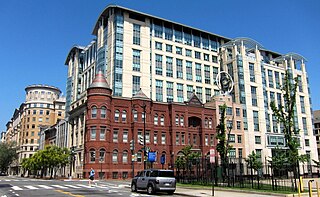
The National Academies of Sciences, Engineering, and Medicine (NASEM), also known as the National Academies, is a congressionally chartered organization that serves as the collective scientific national academy of the United States. The name is used interchangeably in two senses: (1) as an umbrella term or parent organization for its three sub-divisions that operate as quasi-independent honorific learned society member organizations known as the National Academy of Sciences (NAS), the National Academy of Engineering (NAE), and the National Academy of Medicine (NAM); and (2) as the brand for studies and reports issued by the unified operating arm of the three academies originally known as the National Research Council (NRC). The National Academies also serve as public policy advisors, research institutes, think tanks, and public administration consultants on issues of public importance or on request by the government.
Forfás was the national policy advisory board for enterprise, trade, science, technology and innovation in Ireland. The agency was established in January 1994 under the Industrial Development Act, 1993 and was run by a board appointed by the Minister for Enterprise, Trade and Employment, to whom the agency was responsible. Forfás was dissolved on 1 August 2014 and its functions were transferred to the Department of Enterprise, Trade and Employment, Enterprise Ireland, the Industrial Development Authority and the Health and Safety Authority.

Ashton Baldwin Carter was an American government official and academic who served as the 25th United States secretary of defense from February 2015 to January 2017. He later served as director of the Belfer Center for Science & International Affairs at Harvard Kennedy School.
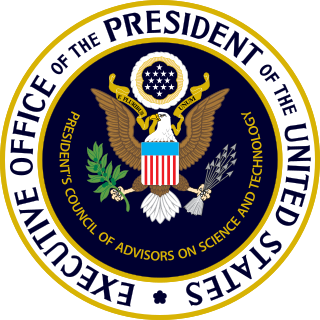
The President's Council of Advisors on Science and Technology (PCAST) is a council, chartered in each administration with a broad mandate to advise the president of the United States on science and technology. The current PCAST was established by Executive Order 13226 on September 30, 2001, by George W. Bush, was re-chartered by Barack Obama's April 21, 2010, Executive Order 13539, by Donald Trump's October 22, 2019, Executive Order 13895, by Joe Biden's February 1, 2021, Executive Order 14007 and by Donald Trump again on January 23, 2025 with Executive Order XXXXX.
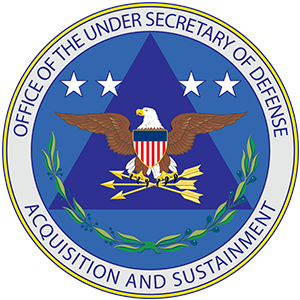
The Under Secretary of Defense for Acquisition and Sustainment, or USD (A&S), is the Principal Staff Assistant (PSA) and advisor to the Secretary of Defense for all matters relating to acquisition and sustainment in the Department of Defense. This includes the DoD Acquisition System; system design and development; production; logistics and distribution; installation maintenance, management, and resilience; military construction; procurement of goods and services; material readiness; maintenance; environment and energy resilience ; utilities; business management modernization; International Armaments Cooperation, Cooperative Acquisition and International Agreements, Promoting exportability of military components to allies and partners; nuclear, chemical and biological defense programs; and nuclear command, control, and communications.
The National Science Advisory Board for Biosecurity (NSABB) is a panel of experts that reports to the Secretary of the United States Department of Health and Human Services. It is tasked with recommending policies on such questions as how to prevent published research in biotechnology from aiding terrorism, without slowing scientific progress.
The Public Interest Declassification Board (PIDB) is an advisory committee established by the United States Congress with the official mandate of promoting the fullest possible public access to a thorough, accurate, and reliable documentary record of significant U.S. national security decisions and activities. The Board is composed of nine individuals: five appointed by the President of the United States and one each appointed by the Speaker of the House, House Minority Leader, Senate Majority Leader, and Senate Minority Leader. Appointees must be U.S. citizens preeminent in the fields of history, national security, foreign policy, intelligence policy, social science, law, or archives.
The Secretary of the Navy's Advisory Subcommittee on Naval History was formally established in 1956 and is the second oldest of the historical advisory committee's within the United States Department of Defense.

The Army Science Board (ASB) provides advice about army science to senior military leaders. The ASB is a Federal Advisory Committee organized under the Federal Advisory Committee Act. It is the United States Department of the Army senior scientific advisory body that was chartered in 1977 to replace the Army Scientific Advisory Panel. The ASB provides the Army with independent advice and recommendations on matters relating to the Army's scientific, technological, manufacturing, logistics and business management functions, as well as other matters the Secretary of the Army deems important to the Department of the Army. The Secretary of the Army delegates oversight authority to the Deputy Under Secretary of the Army, who appoints the ASB Executive Director. Terms are generally three years.

The Assistant Secretary of the Air Force (SAF/AQ) is a civilian position in the Department of the Air Force that is appointed by the president of the United States and confirmed by the United States Senate. This position is established under Title 10 US Code Section 9016 and is one of five Assistant Secretary positions under the Secretary of the Air Force. The Assistant Secretary reports to the Secretary of the Air Force.
The Office of the United States Assistant Secretary of the Army for Acquisition, Logistics, and Technology (ASA(ALT) pronounced A-salt) is known as OASA(ALT). OASA(ALT) serves, when delegated, as the Army Acquisition Executive, the Senior Procurement Executive, the Science Advisor to the Secretary of the Army, and as the senior research and development official for the Department of the Army. The OASA(ALT) also has the principal responsibility for all Department of the Army matters related to logistics.

Amanda Renae Simpson is an American pilot, businessperson and politician.
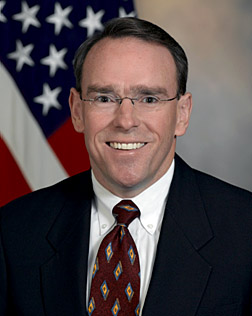
John Jacob Young Jr. was United States Assistant Secretary of the Navy from 2001 to 2005 and Under Secretary of Defense for Acquisition, Technology and Logistics from 2007 to 2009. He is the founder and principal of JY Strategies, LLC.
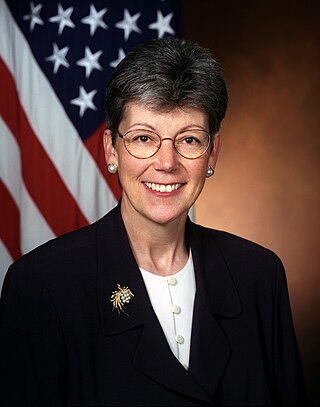
Delores Maria Etter is a former United States Deputy Under Secretary of Defense for Science and Technology from 1998 to 2001 and former Assistant Secretary of the Navy for research, science, and technology from 2005 to 2007.

The Under Secretary of Defense for Research and Engineering, abbreviated USD (R&E), is a senior official of the United States Department of Defense. The USD (R&E) is charged with the development and oversight of technology strategy for the DoD. The post has at various times had the titles Assistant Secretary of Defense for Research and Engineering, or Director of Defense Research and Engineering (DDR&E). The latter title has itself historically varied between the rank of under secretary and that of assistant secretary.
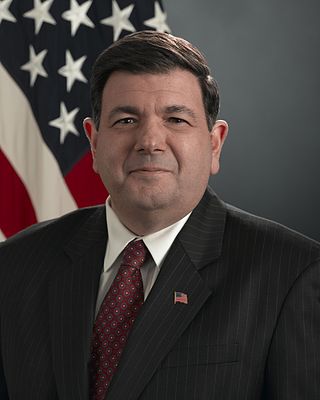
Zachary John Lemnios is an American scientist, executive, and engineer who has worked in government, industry, and academia. Most notably, he held the post of Assistant Secretary of Defense for Research and Engineering from 2009 to 2012, and he has served as the first Chief Technology Officer of MIT Lincoln Laboratory, and as Vice President of Research at IBM. Lemnios later founded ZJL Consulting, LLC.
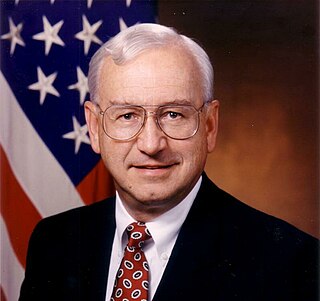
Paul Garrett Kaminski is a technologist and former U.S. government official, best known for his leading role in the development of stealth aircraft.
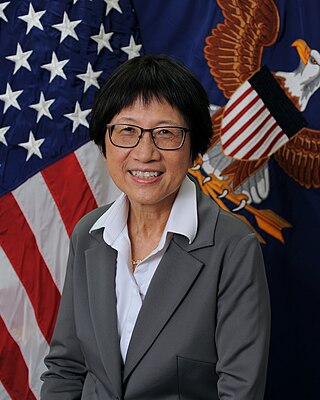
Heidi Shyu is a Taiwanese-born American engineer who had served as the Under Secretary of Defense for Research and Engineering in the Biden administration. She previously served as the United States Assistant Secretary of the Army for Acquisition, Logistics, and Technology ASA(ALT) from 2012 to January 30, 2016.

The United States Army Acquisition Corps (AAC) is the officer / NCO corps of the United States Army Acquisition Workforce (AAW), a branch which includes civilians, officers, and NCOs. The Acquisition Corps is composed of army officers who serve in acquisition, a specialized form of product development, fielding, and support and Noncommissioned Officers who specialize in Contracting, Level I Program Management and Purchasing. These officers begin their careers in the other branches of the army for eight years, after which they may elect the Acquisition branch as their career as assistant program managers (APMs), program managers (PMs), and program executive officers (PEOs). The Noncommissioned Officers (NCOs) are reclassified in the Army Acquisition NCO Corps after serving 7-10 years in their respective enlisted career management fields, and serve primarily in the Army Acquisition Career Management Field - 51 and (MOS) 51C. 4% percentage of the Army Acquisition Officers serve among the 40,000 members of the army acquisition workforce, 6% in MOS 51C - Acquisition, Logistics and Technology Contracting Noncommissioned Officer, and the remainder 90% percentage consist largely of Department of the Army civilians.

John P. Stenbit is an American engineer and public official who served as the Assistant Secretary of Defense for Networks and Information (NII) (2003-2004) and Assistant Secretary of Defense (C3I) (2001) during the Presidency of George W. Bush.